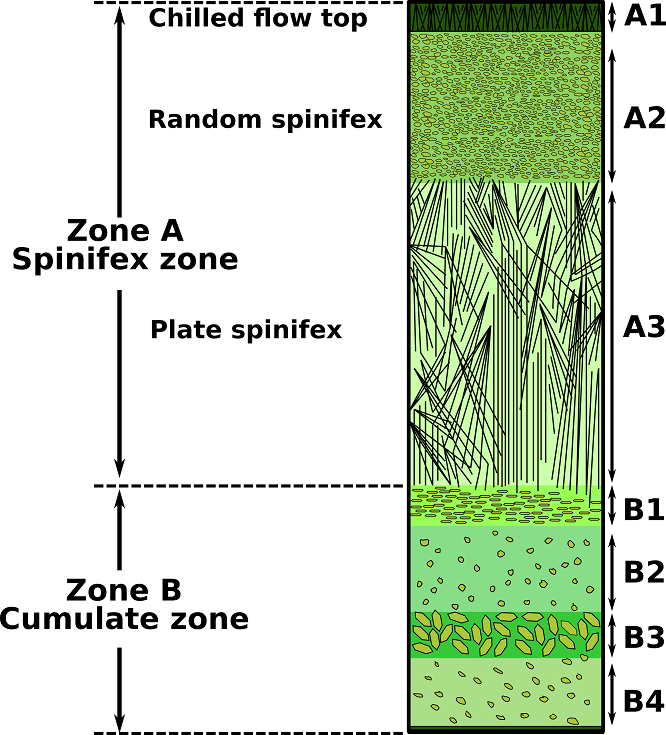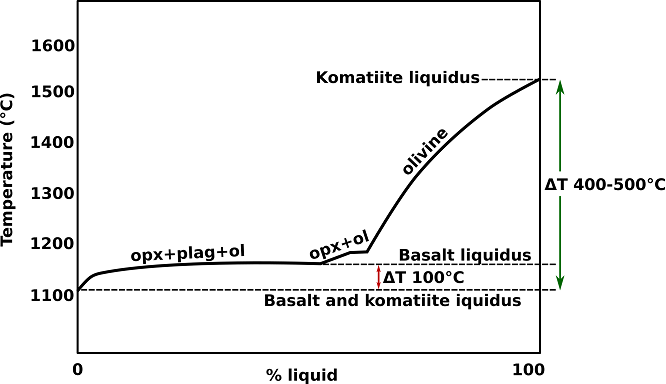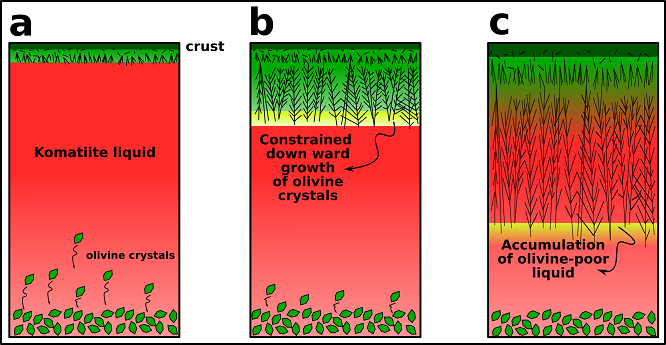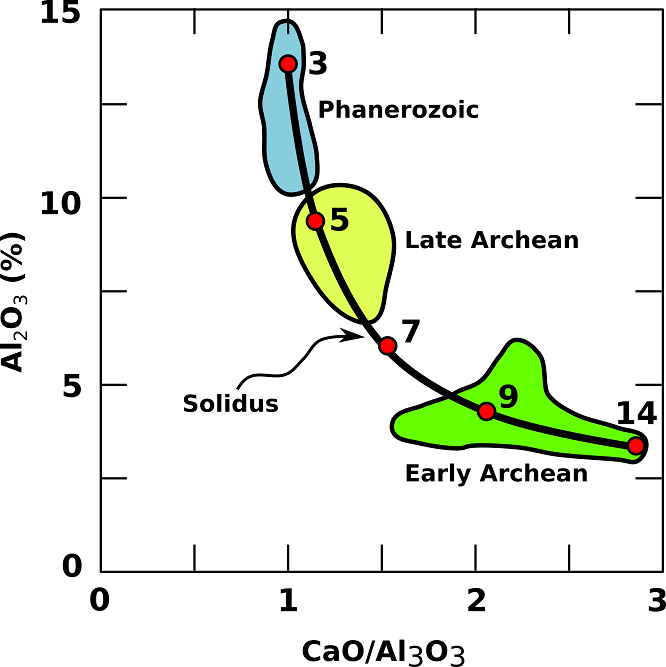Komatiites
Komatiites are fascinating volcanic rocks. They are among the most ancient lavas of the Earth following the 3.8 Ga pillow basalts at Isua and they represent some of the oldest ultramafic magmatic rocks preserved in the Earth’s crust at 3.5 Ga. This fact, linked to their particular features (high magnesium content, high melting temperatures, low dynamic viscosities, etc.), has attracted the community of geoscientists since their discovery in 1969. Komatiites were first identified by Richard and Morris Viljoen in 1969, in the Archean greenstone belt in the Barberton Mountain land of South Africa as a distinctive and "new" class of magnesium-rich (20-30 wt % MgO) volcanic rocks. The Viljoen brothers inferred that the rocks had characteristics of erupted liquids with distinctive chemical composition and named them after the Komati River flowing through the type locality. These 3.5 Ga flows are among the oldest known ultramafic rocks. Similar ultramafic lavas were soon described from other Archean and Paleoproterozoic belts particularly from Canada, Africa, Australia and Finland. Most komatiites are Neoarchean to Paleoproterozoic, but extend into the Phanerozoic, including Permian-Triassic komatiites from NW and Cretaceous (90 Ma) komatiites from Gorgona Island off the coast of Columbia.In the official IUGS recommendations a komatiite is defined as a high-Mg volcanic rock with 52 % > SiO2 > 30 %, MgO > 18 %, (NaO2 + K2O) < 2 % and TiO2 < 1 % (Le Bas 2000, Le Maitre et al. 2002). Kerr and Arndt (2001) have also emphasized that komatiites should display characteristic textural features such as spinifex (bladed and acicular olivine, and/or pyroxene crystals in fine-grained matrix). However, spinifex-like undercooling textures are not only restricted to komatiites. Because all komatiites do not display spinifex texture, Arndt and Fowler (2004) defined komatiites as ultramafic rocks that either contain spinifex texture or are related to rocks that do.
Geological environment and textures
Almost all known Archaean komatiites are preserved as lavas in deep submarine volcanic and sedimentary successions (greenstone belts) and as intrusions in the subjacent crust that forms part of Archaean cratons. Komatiite lavas were almost certainly erupted in subaerial and shallow marine environments as well, but they have been eroded. Although some vesicular komatiite lavas exist, pyroclastic komatiite successions have been only rarely recognized. These include primary and variably reworked deposits of shards, vesicular pyroclasts, and accretionary lapilli. Komatiite units can be tens or even hundreds of metres thick and can be traced continuously for up to 20 km, indicating that komatiite eruptions were major events during the Precambrian. Komatiite lavas are famous for their unique olivine spinifex and cumulate crystal textures and internal textural zonation. In komatiitic basalts, such textures can also involve pyroxene.In a typical komatiite lava, the textural profile of the lava from top to bottom (Fig.1) consists of the following (Arndt et al., 1977):
Zone A: characterized by spinifex-textured rock.
Zone B: containing a high proportion of equant olivine crystals resembling various peridotite to dunite cumulates.
Both zones have been further subdivided into several subzones, although the individual subzones may not be continuous and may occasionally be absent:
A1 chilled margin: This uppermost layer is aphyric or extremely fine grained and only a few mm to a few cm thick.
A2 Random spinifex texture: Gradationally under A1, there is a layer of apparent needle-like, but actually blade-like, skeletal crystals of olivine with a random orientation. These crystals increase in size downward from a few mm to several cm.
A3 Blade spinifex texture: This layer gradationally underlies A2 and consists of sets of blade-like crystals that are stacked at slightly different angles against each other and have a subvertical orientation. Sets of blades increase in size downward. They can be a cm to tens of cm in length, and in some cases, m in length. The base of this textural zone is sharp and may be planar to gently undulating.
B1 Harrisitic texture: This zone is a cm to tens of cm thick and consists of skeletal crystals, which may be elongate to equant in form. They can have comb-like shapes and have a sub-horizontal orientation.
B2 Cumulate texture: massive medium- to fine-grained cumulate composed mainly of equant olivine crystal.
B3: coarse-grained equant olivine cumulates.
B4: massive cumulate composed of olivine crystals with chilled basal margin.
Komatiite lavas are highly fluid because of their low viscosity and high liquidus temperature, so they would be expected to form rather thin flows. The thick komatiitic flows were probably ponded (lava lakes and rivers) or were thickened by flow inflation (flow ballooning) due to repeated flow pulses, like pahoehoe basalts of Kilauea, Hawaii. Komatiite lavas are inferred to have the ability to flow over considerable distances from eruption. Once a solid crust formed around a flow, it would create an efficient insulating surface that would facilitate the flow of hot komatiitic lava.

Fig.1: Variations in texture across a several metre-thick komatiite flow, showing well developed layering. Modified from Dostal, J. (2008).
Mineralogy and petrology
Komatiites and related rocks have been affected to variable degrees by metamorphism, hydrothermal and seafloor alteration, and deformation, which have, at least in part, obliterated the original textures and primary mineralogy. Hence, komatiites generally contain metamorphic minerals in place of their primary assemblages, relics of which may nonetheless be fortuitously preserved in some instances. Low-grade metamorphism of komatiites produced mineral assemblages dominated by serpentine–antigorite, chlorite, talc, tremolite, magnesite-dolomite and magnetite. At higher metamorphic grades, metamorphosed komatiites contain anthophyllite, enstatite, olivine and diopside.The primary mineralogy of komatiites is simple: phenocrysts of olivine and spinel/chromite (± pyroxene) are enclosed in a groundmass composed of glass, calcic clinopyroxene and minor orthopyroxene. In the spinifex-textured komatiites, elongate and skeletal olivine (or pyroxene in komatiitic basalts) blades ranging in length from mm to tens of cm are set in a fine-grained matrix that originally contained a large proportion of volcanic glass ranging in composition from komatiite to komatiitic basalt.
Origin of spinifex texture
Nesbitt (1971) formally introduced the term spinifex when he described and classified several different types of skeletal crystals in komatiites from Australia and Canada. The term derives from an Australian spiky grass (Triodia spinifex).Petrologists who initially studied spinifex texture noticed that the skeletal olivine phenocrysts in komatiites resemble quench crystals (formed at very rapid cooling rates) in experimental melt. Solidification under the conditions of supercooling (low nucleation rates and rapid crystal growth rates) produces a few large skeletal or dendritic crystals. However, this model cannot explain the occurrence of spinifex texture within thick komatiite flows well below the upper chilled crust. Large skeletal crystals may have crystallized at depths, many metres below the surfaces of the flows where cooling rates must have been low.
Nesbitt was first to recognize what has come to be known as the spinifex paradox: Spinifex texture is commonly found in the interior of komatiite flows, well below the upper chilled crust. In the thickest units, large dendritic crystals appear to have crystallized at depths 10 or more meters below the surface of the flow. Under such circumstances, the loss of heat from the interior of the flow is controlled by conduction through the upper solidified crust. In a typical 2-m-thick komatiite flow, the cooling rate during crystallization of the lower part of the spinifex layer is only 1 to 3°C per hour. In thicker flows the rate is far lower. In contrast, the morphologies of the olivine or pyroxene crystals in spinifex-textured lavas resemble those produced experimentally at cooling rates never less than about 30°C/hr.
As the spinifex texture is confined to MgO-rich basaltic to ultramafic rocks, a partial explanation is that spinifex texture is related to the temperature difference between the liquidus and solidus (Fig.2), which is very large for komatiites and Mg-rich rocks (400-500°C; Faure et al. 2006) compared with typical basaltic rocks (<100°C). However, in detail, the origin of the spinifex texture remains problematic.

Fig.2: Diagram of percentage liquid vs temperature illustrating the large difference in the liquidus-solidus gap between komatiite and basalt. Modified from Arndt, N., & Fowler, A. (2004).
A factor that has been mentioned in many papers on spinifex texture, but has not received sufficient attention, is the role of constrained crystal growth during solidification of the crust of a komatiite flow. Constrained growth refers to the crystallization of parallel grains of olivine or pyroxene in the downward-growing crust of a lava flow. The crystals compete with one another for nutrients. Probably it is this competition that leads to the preferred, near-perpendicular orientation of the olivine crystals in spinifex textures (Fig.3).

Fig.3: Three stages during the solidification of a spinifex-textured komatiite flow. Modified from Arndt, N., & Fowler, A. (2004).
Erupted komatiite contains a small proportion of olivine phenocrysts that grew either during ascent to the surface or during flowage on the surface. During cooling, some of these phenocrysts become trapped in the crust that forms right at the top of the flow, others settle towards to the base of the flow and become part of the lower cumulate layer. Olivine then nucleates in the layer of crystal-free liquid just beneath the crust. The crystals that grow from these nucleii have highly skeletal morphologies, due to the high cooling rate in the crust of the flow, and they are randomly oriented.
As cooling proceeds, these olivine grains continue to grow. Those with a near-vertical orientation are favored because their tips extend downwards into unfractionated nutrient-rich liquid; those with orientations closer to horizontal find only nutrient-poor liquid or collide with other crystals, and they cease to grow. The crystallization of olivine produces a residual liquid with a composition different from that of the parental liquid, depleted in Mg and enriched in Si, Al, Ca and Na. Its density is less than that of the parental liquid. As downward growth proceeds, this liquid is expelled and it accumulates as a layer of low-density at the base of the crystal front (Turner et al., 1986). The growing tips of the spinifex crystals are bathed in a liquid depleted in the components they require to grow.
Komatiite petrogenesis
From the time of their discovery, there has been active debate about the melting conditions required to produce liquids of komatiitic composition. Komatiites represent primitive mantle melts and require high degree partial melting of the mantle (up to 50 %) (Nesbitt & Sun 1976, Sun & Nesbitt 1978). The formation of komatiites has generally been attributed to mantle plume upwelling and related volcanism in a variety of geodynamic settings mainly during the Archean and early Proterozoic. The predominance of komatiites in the Archean, their decreasing occurrence in the Proterozoic, and extreme rarity in the Phanerozoic have been interpreted to reflect secular cooling of the mantle (by up to 400°C; Nisbet et al. 1993).Because the MgO contents of anhydrous magmas are proportionally related to their melting temperature (higher MgO results from higher melting temperatures), komatiite melts require significantly higher temperatures than the 1250-1350°C responsible for recent MORB. Traditionally, most petrologists have accepted that during the Archean and Paleoproterozoic, komatiite melting temperatures ranged from 1600-1900°C.
Because CaO/Al2O3 is strongly pressure dependent, Herzberg (1995) used an Al2O3-CaO/Al2O3 plot to estimate the depth of melting of komatiite magmas. Fig. 4 shows that the Paleoarchean komatiites, which have low Al2O3 and high CaO/Al2O3, were generated at depths of 300-450 km (9-14 GPa), Neoarchean komatiites from depths of 150-200 km (5-6.5 GPa), and young komatiites (< 100 Ma old) from depths of 100-130 km (3-4 GP).

Fig.4: Al2O3 (wt.%) vs. CaO/Al2O3 diagram showing the distribution of komatiites relative to the mantle solidus (heavy solid line), which is depicted as a function of the variation of pressure given in GPa (1 GPa is approximately equivalent to 10 kb). The komatiites are subdivided according to their age. The group of Phanerozoic rocks (< 100 Ma) includes picrites. Solidus represents conditions at which the mantle will begin to melt. Modified from Dostal, J. (2008).
.jpg)
Large, downward-radiating spinifex textures in komatiitic. Komati River Valley, South Africa. From Large igneous provinces.
.jpg)
Spinifex metakomatiite. Komati River Valley, South Africa. From James St. John.
.jpg)
Spinifex komatiite sills in cumulate komatiite lava flow (Upper Komatiitic Unit). Kidd-Munro Assemblage, Timmins, Ontario, Canada. From James St. John.
.jpg)
Spinifex komatiite. Kidd-Munro Assemblage, Timmins, Ontario, Canada. From James St. John.
.jpg)
Spinifex komatiite. Kidd-Munro Assemblage, Timmins, Ontario, Canada. From James St. John.
.jpg)
Spinifex komatiite. Kidd-Munro Assemblage, Timmins, Ontario, Canada. From Craig Scott.
.jpg)
Spinifex komatiite. Abitibi greenstone belt, Canada. From Reddit.
Bibliography
• Arndt, N. T., & Lesher, C. M. (2016). IGNEOUS ROCKS| Komatiite.
• Arndt, N., & Fowler, A. (2004). Textures in komatiites and variolitic basalts.
• Dostal, J. (2008). Igneous rock associations 10. Komatiites. Geoscience Canada.
• Höytiä, H. (2019). Komatiites of eastern Lapland and their Ni-Cu-PGE potential.
• Nna-Mvondo, D., & Martinez-Frias, J. (2007). Review komatiites: from Earth’s geological settings to planetary and astrobiological contexts. Earth, moon, and planets, 100(3-4), 157-179.
• Viljoen, M., & Viljoen, R. (2019). Discovery and significance of komatiite: 50th Anniversary. South African Journal of Science, 115(11-12), 1-2.

